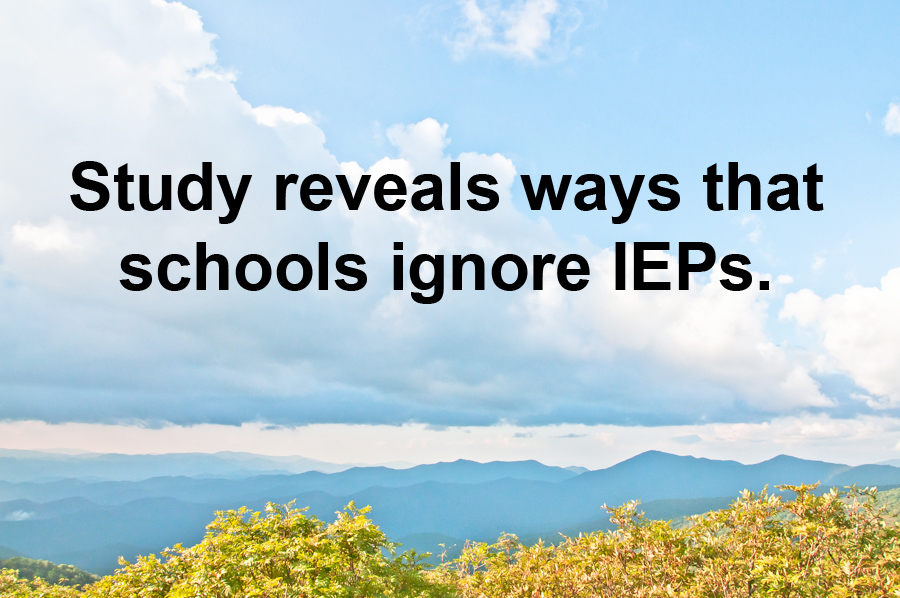The Individual Education Program (IEP) is the cornerstone of special education. It is a legal contract between the school district and parents that defines what specialized instruction, accommodations, and modifications are necessary for a child to receive the Free Appropriate Public Education (FAPE) required by law. Since each child in special education has unique needs, by definition the IEP must be individualized based on what objective testing reveals about a child’s disabilities and capabilities.
A study, published in 2018 in the journal, Educational Evaluation and Policy Analysis, has uncovered disturbing trends in the way that schools create and implement IEPs that appear to violate special education law. This study, titled (with typical academic brevity), “The Dynamic Interaction Between Institutional Pressures and Activity: An Examination of the Implementation of IEPs in Secondary Inclusive Settings,” states that its purpose is to “illuminate a dynamic interaction between institutional pressures and the activity of providing students with a special education.”
The study identified different approaches that two schools took in creating and implementing IEPs that circumvent the intention of the Individuals with Disabilities Education Act (IDEA). While this study was undertaken with the goal of influencing the anticipated congressional revision and reauthorization of IDEA and not as an indictment of special education in general, you may want to consider its implications for how your school implements your child’s IEP.
Two Ways to Ignore the Law
In one school, the study discovered that the IEPs for 10th and 11th grade students were written around the school’s existing curriculum for general education. The school would then follow the students’ IEPs, but without acknowledging that the services were simply based on getting the students to pass their general education courses and standardized tests. As a result, the students in special education did not receive the educational services and supports that their disability required. The study cites “institutional pressures” (no doubt including the school budget) as the reason, something the study’s authors point out is not the purpose of an IEP, much less special education.
The second school in the study wrote IEPs for each student that were individualized, but then mostly ignored them. Instead, the school relied on additional staff in the general education classroom as a way to provide more support for the special education students. In addition, these students attended a daily special education “study hall,” where they received more support. While the students in the second school had greater access to the special education curriculum than the first school, it was without the benefit of a program “designed to meet their unique needs,” the purpose of special education. [20 USC § 1400 (d)(1)(A)]
What Can We Learn From This?
It is important to remember that this study had a small sample size and is just the first of several planned studies with the goal of encouraging debate among educators and legislators on how to update special education law. Among future studies, the authors hope to focus on how to improve the creation and implementation of IEPs for special education students included in the general education classroom.
Still, we can extrapolate from this study that even after more than forty years of special education law and practice, there is a lot of uncertainty, and perhaps reluctance, on the part of schools to provide an appropriate education for students with disabilities. This is something that parents must understand and be prepared to deal with.
What You Can Do
Making sure schools are following the law is a responsibility that should not have to be left to parents. Still, the reality is that in addition to parenting a child with disabilities, you also have the job of being a watchdog over the school’s implementation of your child’s education.
Here are some suggestions to help you do that:
Make sure that all services, accommodations, and modifications are clearly definedin the IEP. See our blog article: The Three Essential Parts of an IEP Goal for some tips.
Create a special education “paper trail” by organizing all the paperwork and other communications with the school that relate to your child’s education. Include samples of your child’s work to illustrate any problems or successes. If you suspect problems, you can use your paper trail to provide evidence of your concerns.
Start a parent journal that, among other things, records your impressions of how your child’s IEP is being implemented.
Arrange a meeting with your child’s teacher to make sure the teacher has a copy of the IEP. Go over any sections that the teacher is responsible for implementing and make sure that you both understand them. Discuss possible ways that you can communicate with each other regarding issues or concerns that may come up. Note that teacher meetings are easier to arrange in elementary school than middle or high school.
IDEA gives schools the ultimate authority over the content and implementation of the IEP.
Contact your state’s Parent Training and Information center (PTI), which is a federally mandated organization to provide parents support and information on how to make the most of their child’s education. The staff at the center should be able to advise you on your rights under IDEA and suggest a course of action.
Make sure this person is fully independent and does not have any conflicts of interest that may prevent this person fully supporting you and your child.
Judith Canty Graves and Carson Graves


